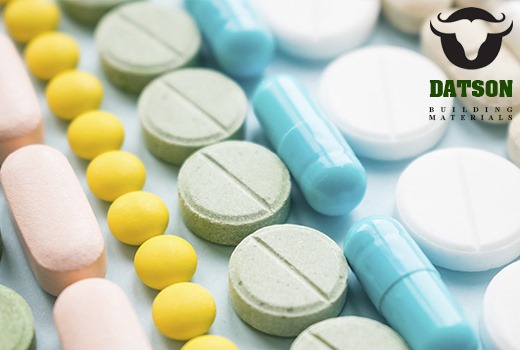Color plays a critical role in how we perceive and interact with oral medications. A tablet’s appearance isn’t just about aesthetics; it influences patient compliance, helps differentiate between drug types, and even serves a functional role in drug stability. In this context, iron oxide pigments in tablet coatings have emerged as a key solution for pharmaceutical manufacturers seeking reliable, safe, and versatile coloring agents.
This article explores the application of iron oxide pigments in tablet coatings, highlighting their regulatory acceptance, functional benefits, and growing role in titanium dioxide-free formulations. With increasing scrutiny over synthetic additives, iron oxides offer a trusted alternative that meets safety standards and consumer expectations alike.
The Role of Color in Oral Pharmaceuticals
Color affects much more than just appearance it influences patient behavior and medication adherence. Tablets that are easily distinguishable by color can reduce dosing errors and improve brand recognition. In pediatric and geriatric populations especially, a tablet’s color can make the difference between regular intake and skipped doses. For manufacturers, consistency in color helps reinforce product identity while aiding pharmacists and caregivers in medicine management.
Overview of Iron Oxide Pigments in Tablet Coatings
Iron oxide pigments are inorganic compounds composed of iron and oxygen, available in a spectrum of shades such as red, yellow, brown, and black. These pigments have been used for decades in food, cosmetics, and pharmaceuticals. Among them, iron oxide red in tablets is widely recognized for its vibrant hue, chemical stability, and compatibility with various coating systems. These pigments are commonly used in both film-coated and sugar-coated tablets, as well as in gelatin capsules.
The application extends beyond just visual enhancement. For example, iron oxide colouring for gelatine based drug formulations ensures consistent appearance while maintaining chemical compatibility with gelatin materials.
Advantages Over Other Pigment Types
Compared to synthetic dyes, iron oxide pigments offer multiple advantages:
- Chemical Stability: They resist light, heat, and pH fluctuations, making them suitable for a wide range of formulations.
- Non-Toxic: Iron oxides are biologically inert and safe for human consumption when used within regulatory limits.
- Opacity: Their high tinting strength allows for lower usage rates while delivering vibrant and uniform color.
- Broad Compatibility: They work well in aqueous and solvent-based coatings, as well as with polymers used in sustained-release tablets.
- These attributes make iron oxide pigments a preferred choice over organic dyes, especially in sensitive formulations.
Regulatory Approvals and Safety
To ensure the safe and effective use of pharmaceutical products, regulatory approvals play a crucial role in maintaining global health standards.
FDA and EMA Approvals for Pharmaceutical Use
Iron oxide pigments enjoy widespread regulatory approval globally. In the United States, the FDA allows the use of specific iron oxides (red, yellow, and black) in drugs, provided they meet strict identity and purity specifications. Similarly, the European Medicines Agency (EMA) has approved their use in medicinal products intended for human use, including both solid and semi-solid forms.
Importantly, iron oxides are among the few color additives approved for internal use, giving them a distinct edge over many synthetic dyes.
Safety Assessments for Oral Consumption
Safety evaluations conducted by global regulatory bodies have affirmed that iron oxide pigments are safe for ingestion at recommended concentrations. Studies have shown that they are poorly absorbed by the gastrointestinal tract, and excess amounts are excreted without accumulation in body tissues.
In addition to iron oxide red in tablets, yellow iron oxide in medicine has also undergone rigorous toxicological assessments. Results consistently show no genotoxic, carcinogenic, or reproductive toxicity risks when used within approved limits.
Dosage and Labeling Restrictions in Various Regions
While generally recognized as safe, the use of iron oxide pigments must comply with regional dosage and labeling requirements. For example, in the EU, iron oxides are identified by specific E numbers (E172) and must be declared on the product label. In the U.S., similar rules apply under the FDA’s Code of Federal Regulations.
Manufacturers are responsible for ensuring that the concentration of each pigment stays within the permitted range and is disclosed appropriately to meet transparency and safety standards.
Advantages in Tablet Coating
When incorporated into coating systems, iron oxide pigments provide a number of practical and aesthetic benefits:
- Color Uniformity: These pigments distribute evenly in coating suspensions, resulting in a smooth, uniform finish.
- Masking Ability: They can effectively mask the appearance of bitter or unsightly core materials.
- Protection Against Light and Moisture: The pigments act as barriers that enhance the stability and shelf life of light-sensitive APIs (Active Pharmaceutical Ingredients).
- Patient-Friendly Design: The use of recognizable colors, such as iron oxide red in tablets, enhances user experience and compliance.
An emerging trend is the increased use of Iron Oxides in Titanium Dioxide-Free Coatings. As health concerns around titanium dioxide rise, many pharmaceutical brands are seeking alternatives that still provide effective opacity and coverage. Iron oxide pigments have stepped in as a natural solution that aligns with clean-label demands.
Challenges and Limitations
Despite their numerous benefits, iron oxide pigments are not without limitations. One concern is the limited color palette compared to synthetic dyes. While hues like Natural Red Iron Oxide and yellow iron oxide are commonly available, achieving bright or unusual colors (like blue or green) typically requires blending or additional colorants.
Additionally, iron oxide pigments are relatively heavy, which can pose formulation challenges, especially in lightweight or low-density coating systems. Some manufacturers may also face compatibility issues when using them with certain polymers or high-viscosity binders.
Another consideration is cost. While not prohibitively expensive, the processing and certification requirements for pharmaceutical-grade iron oxides can make them more costly than food-grade or cosmetic-grade alternatives.
Future Outlook for Usage in Pharmaceutical Coatings
The future of iron oxide pigments in tablet coatings looks promising. With the global push toward cleaner, more natural pharmaceutical ingredients, demand for inorganic, non-synthetic colorants is rising. Iron oxide pigments are ideally positioned to meet this demand due to their safety, stability, and regulatory acceptance.
Technological advancements in pigment dispersion and coating equipment are also helping to overcome previous formulation challenges. For instance, newer micronized versions of iron oxide red in tablets provide better suspension properties, improving uniformity and processing efficiency.
Moreover, as the pharmaceutical industry moves away from titanium dioxide, iron oxides are expected to play a larger role in the development of next-generation coatings that are both functional and consumer-friendly.
Companies like Datson are investing in research and development to create innovative formulations using iron oxide pigments that are cost-effective and compliant with global regulatory standards. These developments are likely to accelerate adoption across both branded and generic drug manufacturers.
Conclusion
Iron oxide pigments have become an indispensable tool in the pharmaceutical coating industry. Their safety profile, chemical stability, and vibrant appearance make them ideal for use in oral medications. Whether it’s the classic appeal of iron oxide red in tablets, the sunlit hue of yellow iron oxide in medicine, or their role in replacing titanium dioxide, iron oxides offer both performance and peace of mind.
As regulatory and consumer preferences continue to evolve, the demand for reliable and natural colorants will only grow. With their proven track record and ongoing innovation, iron oxide pigments in tablet coatings are well-positioned to meet the challenges of modern pharmaceutical formulation offering color with confidence, function, and safety.





